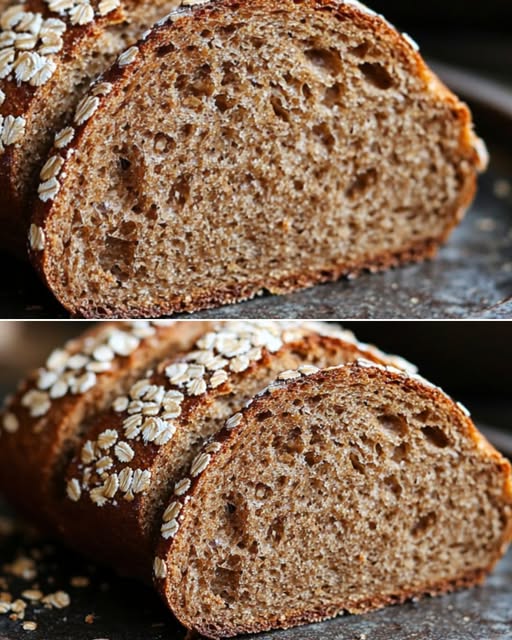Discover the rustic charm of traditional European bread-making with this naturally gluten-free buckwheat sourdough bread. This ancient grain recipe produces a gorgeously textured loaf with a nutty flavor profile and a beautiful crust adorned with golden seeds. Perfect for those seeking authentic, wholesome bread without gluten.
Ingredients
For the Bread:
- 400g (14.1 oz) green buckwheat groats
- 160ml (⅔ cup) filtered water
- 1 teaspoon (5g) unsalted butter
- 2 teaspoons (10g) psyllium husk
- 1 teaspoon (5g) sea salt
For the Spice Blend:
- 1 teaspoon caraway seeds
- 1 teaspoon fennel seeds
- ½ teaspoon dried thyme
- ½ teaspoon black pepper
For Topping:
- 2 tablespoons pumpkin seeds
- 2 tablespoons sunflower seeds
- 1 tablespoon olive oil for greasing
Step-by-Step Instructions
Day 1 – Preparation (10 hours soaking):
- Rinse buckwheat groats thoroughly under cold water
- Place in a large bowl and cover with filtered water
- Let soak for 10 hours or overnight
- Drain and rinse thoroughly until water runs clear
Day 2 – Making the Dough:
- Drain soaked buckwheat and blend in a food processor until smooth
- Add water gradually while blending
- Transfer to a bowl and mix in:
- Melted butter
- Psyllium husk
- Salt
- Spice blend
- Mix thoroughly until well combined
- Transfer to an oiled bread pan
- Cover with a damp cloth
- Let ferment at room temperature (68-72°F/20-22°C) for 15-18 hours
Day 3 – Baking:
- Preheat oven to 480°F (250°C)
- Brush top with water and sprinkle with seeds
- Place bread in oven and immediately reduce to 464°F (240°C)
- Bake for 10 minutes
- Open oven door for 30 seconds to release steam
- Reduce temperature to 375°F (190°C)
- Continue baking for 40 minutes
- Cool completely before slicing
Nutritional Information
(Per slice, based on 12 slices)
- Calories: 145
- Protein: 6g
- Carbohydrates: 28g
- Fiber: 4.5g
- Fat: 3g
- Iron: 1.8mg
- Magnesium: 86mg
Total Time:
- Soaking: 10 hours
- Fermentation: 15-18 hours
- Preparation: 20 minutes
- Baking: 50 minutes
- Total Time: 28-31 hours
Pro Tips and Tricks
- Water Temperature: Use room temperature water for optimal fermentation
- Grinding: Don’t over-process the soaked buckwheat – some texture is desirable
- Fermentation: Look for small bubbles and a slightly sour smell
- Humidity: Keep dough covered but allow some airflow
Variations and Substitutions
- Grain Options:
- Mix in 100g quinoa for varied texture
- Add 50g millet for extra nutrition
- Include 2 tablespoons chia seeds
- Flavor Additions:
- Fresh herbs (rosemary, thyme)
- Dried fruit and nuts
- Caramelized onions
- Roasted garlic
- Seed Variations:
- Sesame seeds
- Poppy seeds
- Flax seeds
- Hemp seeds
Common FAQs
Q: Why use green buckwheat instead of regular?
A: Green buckwheat is raw and will ferment naturally, while regular buckwheat is roasted and won’t ferment as well.
Q: Can I speed up the fermentation process?
A: While not recommended, you can add 1 tablespoon of apple cider vinegar and reduce fermentation to 8 hours.
Q: Why does my bread seem too dense?
A: Ensure proper hydration and fermentation time. The psyllium must fully hydrate to create proper structure.
Q: Can I make this bread without psyllium?
A: Psyllium is crucial for structure in gluten-free breads. Ground chia seeds can be substituted but will change the texture.
Storage and Make-Ahead Tips
Room Temperature Storage:
- Keep in a bread box or paper bag
- Best consumed within 2-3 days
- Slice only when ready to eat
Freezing Instructions:
- Cool completely
- Slice entire loaf
- Wrap individual portions in parchment
- Place in freezer bag
- Freeze up to 3 months
- Thaw at room temperature
- Toast before serving
Refreshing Tips:
- Sprinkle with water
- Warm in oven at 350°F (175°C) for 5-10 minutes
- Best eaten warm with butter
This ancient grain bread is not just a loaf – it’s a journey into traditional fermentation and artisanal baking techniques. The long fermentation develops complex flavors while making nutrients more bioavailable. Perfect for special diets, this bread proves that gluten-free can be both nutritious and delicious.
